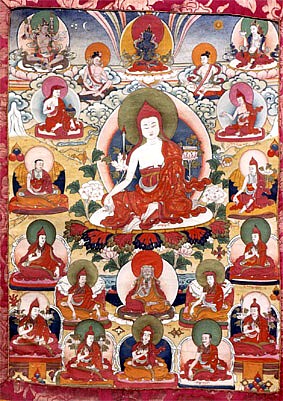頁面 "Shentong" 與 "Shangpa Kagyü 香巴噶舉" 間的差異
SSTC Serena(對話 | 貢獻) (SSTC Serena 已移動頁面 Shentong 至 Shentong 中觀他空派) |
SSTC Serena(對話 | 貢獻) 小 (SSTC Serena 已移動頁面 Shangpa Kagyü 至 Shangpa Kagyü 香巴噶舉) |
||
| 行 1: | 行 1: | ||
| − | + | [[Image:KhyungpoNaljor.jpg|frame|[[Khyungpo Naljor]]]] | |
| + | The '''Shangpa Kagyü''' ([[Wyl.]] ''shangs pa bka' brgyud'') school was founded by [[Khyungpo Naljor]] (1002-1064) who was prophesied by the [[Buddha]]. He made his seat in a place called Shang in the [[Tsang]] region of Tibet. He was therefore known as the Lama Shangpa and his lineage the Shangpa Kagyü. [[Thangtong Gyalpo]] and Jetsün [[Taranatha]] were among the great masters who upheld this lineage, which is one of the [[Eight practice lineages]]. In the 19th century, when the lineage was almost extinguished, the great masters [[Jamgön Kongtrul Lodrö Thayé]] and [[Jamyang Khyentse Wangpo]] gathered together the transmissions of the different branches and gave renewed energy to the lineage. [[Kalu Rinpoche]] and [[Bokar Rinpoche]] were the recent heads of this school, and founded a great number of centres in the West. | ||
| + | |||
| + | ==Oral Teachings Given to the [[About Rigpa|Rigpa]] Sangha About the Shangpa Kagyü Lineage== | ||
| + | *[[Yangsi Kalu Rinpoche]], [[Lerab Ling]], 12 April 2010 | ||
| + | |||
| + | ==Further Reading== | ||
| + | *E. Gene Smith, 'The Shangs pa Bka' rgyud Tradition' in ''Among Tibetan Texts'', Boston: Wisdom Publications, 2001 | ||
| + | *Matthew Kapstein, “The Shangs-pa bKa'-brgyud: an unknown school of Tibetan Buddhism”. In ''Studies in Honor of Hugh Richardson'', ed. Michael Aris and Aung San Suu Kyi. Warminster: Aris and Phillips, 1980 pp. 138-144. | ||
| + | *Nicole Riggs, ''Like an Illusion: Lives of the Shangpa Kagyu Masters'', Dharma Cloud Pr, 2001. | ||
| + | *''Timeless Rapture: Inspired Verse of the Shangpa Masters'', compiled by Jamgon Kongtrul Lodro Thaye, translated and introduced by Ngawang Zangpo, Snow Lion, 2003. | ||
| + | *[[Ringu Tulku]], ''The Ri-me Philosophy of Jamgön Kongtrul the Great'' (Boston & London: Shambhala Publications, 2006), pages 143-146 & 180-182. | ||
| + | |||
| + | ==Internal Links== | ||
| + | *[http://www.rigpawiki.org/index.php?title=Category:Shangpa_Kagy%C3%BC_Masters Shangpa Kagyü Masters] | ||
| + | *[http://www.rigpawiki.org/index.php?title=Category:Shangpa_Kagy%C3%BC_Teachers Contemporary Shangpa Kagyü Teachers] | ||
| + | *[[Six Yogas of Niguma]] | ||
| + | |||
| + | ==External Links== | ||
| + | *[http://www.shangpa.net The Shangpa Network] | ||
| + | |||
| + | [[Category: Schools and Lineages]] | ||
| + | [[Category: Shangpa Kagyü]] | ||
於 2021年1月19日 (二) 15:29 的最新修訂
The Shangpa Kagyü (Wyl. shangs pa bka' brgyud) school was founded by Khyungpo Naljor (1002-1064) who was prophesied by the Buddha. He made his seat in a place called Shang in the Tsang region of Tibet. He was therefore known as the Lama Shangpa and his lineage the Shangpa Kagyü. Thangtong Gyalpo and Jetsün Taranatha were among the great masters who upheld this lineage, which is one of the Eight practice lineages. In the 19th century, when the lineage was almost extinguished, the great masters Jamgön Kongtrul Lodrö Thayé and Jamyang Khyentse Wangpo gathered together the transmissions of the different branches and gave renewed energy to the lineage. Kalu Rinpoche and Bokar Rinpoche were the recent heads of this school, and founded a great number of centres in the West.
目錄
Oral Teachings Given to the Rigpa Sangha About the Shangpa Kagyü Lineage
- Yangsi Kalu Rinpoche, Lerab Ling, 12 April 2010
Further Reading
- E. Gene Smith, 'The Shangs pa Bka' rgyud Tradition' in Among Tibetan Texts, Boston: Wisdom Publications, 2001
- Matthew Kapstein, “The Shangs-pa bKa'-brgyud: an unknown school of Tibetan Buddhism”. In Studies in Honor of Hugh Richardson, ed. Michael Aris and Aung San Suu Kyi. Warminster: Aris and Phillips, 1980 pp. 138-144.
- Nicole Riggs, Like an Illusion: Lives of the Shangpa Kagyu Masters, Dharma Cloud Pr, 2001.
- Timeless Rapture: Inspired Verse of the Shangpa Masters, compiled by Jamgon Kongtrul Lodro Thaye, translated and introduced by Ngawang Zangpo, Snow Lion, 2003.
- Ringu Tulku, The Ri-me Philosophy of Jamgön Kongtrul the Great (Boston & London: Shambhala Publications, 2006), pages 143-146 & 180-182.
